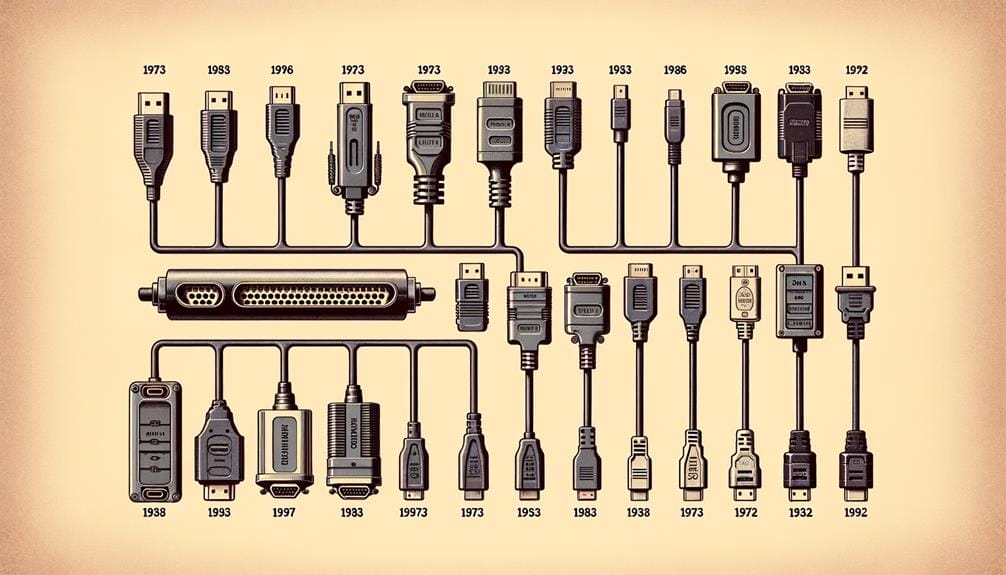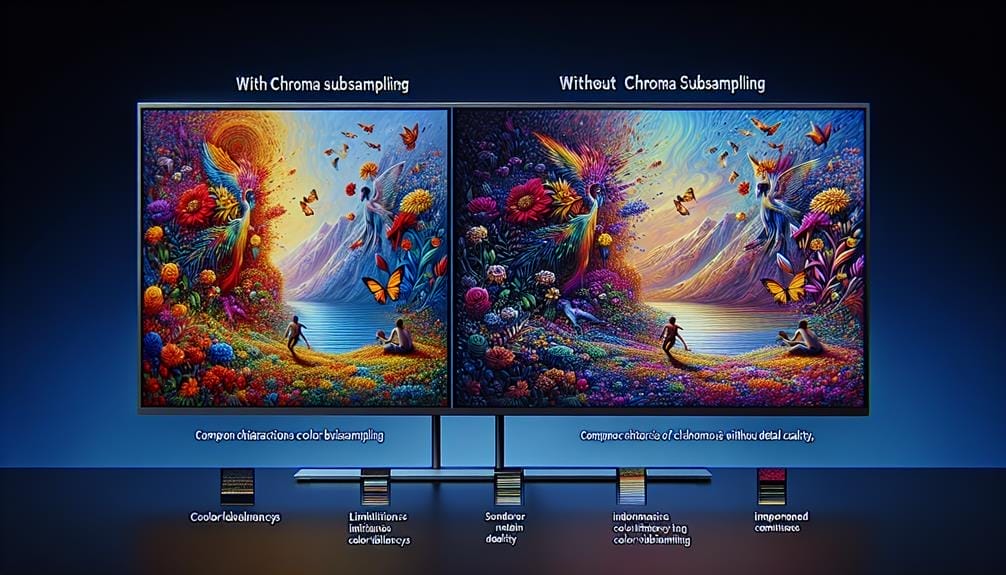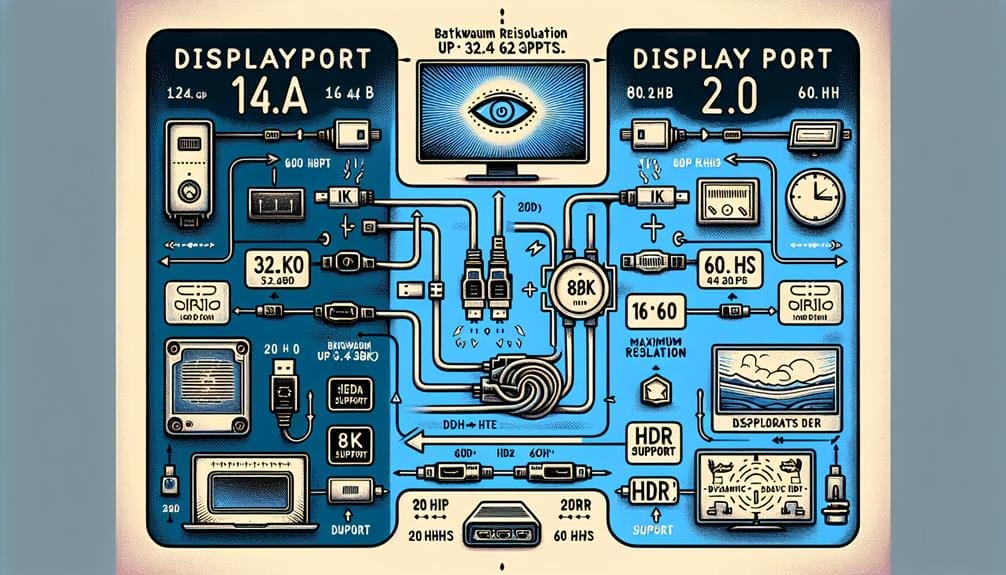Unveiling the Evolution of DisplayPort Technology

DisplayPort technology has seen remarkable advancements, revolutionizing the way we experience visual media. The launch of DisplayPort 1.4A marked a significant breakthrough, introducing critical features like Display Stream Compression and HDR10 metadata. Following this, DisplayPort 2.0 arrived as a pivotal development, introducing a range of transformative improvements. Every step forward in DisplayPort technology represents a substantial leap, significantly improving our visual experiences.
The tripling of throughput to 77.37 Gigabits per second, the enablement of dual 8K displays at 120 Hz, and the promise of reduced power consumption and improved chroma subsampling all point to a future of unparalleled display capabilities.
The impact of these advancements on the realm of high-resolution displays is undeniable, setting the stage for what lies ahead in the ever-evolving world of display technology.
Key Takeaways
- DisplayPort 2.0 is the next major step up from DisplayPort 1.4, offering triple the throughput to 77.37 Gigabits per second.
- DisplayPort 2.0 enables dual 8K displays at 120 Hz, providing improved support for high-resolution and high-refresh rate displays.
- DisplayPort 2.0 reduces power consumption compared to DisplayPort 1.4A, thanks to features like Panel Replay that allow partial screen updates.
- DisplayPort 2.0 enhances HDR support, enabling 4:4:4 color with HDR enabled even at high resolutions, improving color reproduction and readability.
DisplayPort 1.4A Features

The DisplayPort 1.4A features, introduced in April 2018, brought significant advancements to the DisplayPort technology. These specifications allow for higher resolutions, refresh rates, and color depths, enabling a more immersive visual experience. DisplayPort 1.4A offers advantages such as enhanced visual quality, reduced bandwidth requirements, and improved error correction capabilities.
The addition of HDR10 metadata and Rec. 2020 color space support further elevates the viewing experience by providing vibrant and lifelike colors. Moreover, the incorporation of Forward Error Correction ensures robust data transmission, reducing the likelihood of visual artifacts and signal degradation.
DisplayPort 2.0 Advancements
DisplayPort 2.0 represents a substantial advancement in display interface technology, introducing significant improvements in bandwidth, HDR support, and power efficiency.
The advancements in DisplayPort 2.0 include:
- Tripling the throughput to 77.37 Gigabits per second
- Enabling dual 8K displays at 120 Hz
- Reducing power consumption with the Panel Replay feature
- Providing higher bandwidth for improved chroma subsampling
- Enhancing HDR support for better image quality
These advancements open up potential applications for DisplayPort 2.0 in various sectors, including high-performance gaming, professional video editing, medical imaging, and advanced visualization systems.
The increased bandwidth and improved HDR support cater to the growing demand for high-resolution and high-refresh rate displays, making DisplayPort 2.0 a promising technology for future display interface requirements.
DisplayPort 2.0 Throughput

Representing a significant leap in data transfer capabilities, DisplayPort 2.0 offers a remarkable throughput of 77.37 Gigabits per second, positioning it as a leading technology in the realm of high-bandwidth display interfaces. This substantial increase in bandwidth enables support for higher display resolutions, refresh rates, and color depths, catering to the demands of modern high-performance display systems. The table below summarizes the bandwidth capabilities and key features of DisplayPort 2.0, highlighting its advancements over its predecessor, DisplayPort 1.4A.
| Feature | DisplayPort 2.0 |
|---|---|
| Throughput | 77.37 Gbps |
| Resolution Support | Dual 8K at 120 Hz |
| Color Depth | 4:4:4 with HDR |
| Power Consumption | Reduced |
| Chroma Subsampling | Improved |
This impressive increase in bandwidth and capabilities makes DisplayPort 2.0 a pivotal technology for driving the next generation of high-resolution, high-refresh rate displays.
Power Efficiency in DisplayPort 2.0
Enhancing power efficiency, DisplayPort 2.0 introduces significant advancements in reducing overall energy consumption while maintaining high-performance display capabilities.
- Panel Replay Feature: Allows partial screen updates, saving power.
- Beneficial for Portable Devices: Benefits AIO PCs and laptops with battery or thermal limitations.
- Reduced Power Consumption: DisplayPort 2.0 reduces power consumption compared to DisplayPort 1.4A.
- Improved Energy Efficiency: Introduces features to minimize power usage during display operations.
- Enhanced Battery Life: The improved power efficiency contributes to extended battery life in portable devices.
DisplayPort 2.0's focus on power efficiency and reduced energy consumption not only aligns with the industry's growing emphasis on sustainability but also enhances the user experience, particularly for those using portable devices where power consumption is a critical factor.
Chroma Subsampling Benefits

The emphasis on power efficiency in DisplayPort 2.0 not only aligns with sustainability goals but also extends to improving chroma subsampling benefits for enhanced bandwidth utilization and image quality.
The inclusion of Panel Replay in DisplayPort 2.0 facilitates partial screen updates, lowering power consumption and benefiting devices with battery or thermal limitations, such as AIO PCs and laptops.
Additionally, the increased bandwidth in DisplayPort 2.0 allows for improved color reproduction through chroma subsampling, which reduces color information to save bandwidth while maintaining high-quality images.
This enhancement is particularly advantageous for high-resolution displays, as it ensures that color and image quality are not compromised even at higher resolutions, ultimately enhancing the overall visual experience.
Enhanced HDR Support
With the introduction of DisplayPort 2.0, significant advancements in HDR support have been realized, marking a pivotal step in enhancing the visual quality and color reproduction capabilities of high-resolution displays. This enhanced HDR support offers several key benefits:
- Expanded Color Gamut: DisplayPort 2.0 enables a wider range of colors, providing more vibrant and lifelike visuals.
- Improved Contrast Ratio: The technology delivers deeper blacks and brighter whites, resulting in enhanced image depth and clarity.
- High Dynamic Range (HDR): DisplayPort 2.0 enhances HDR support, ensuring a more extensive range of luminance levels for a more realistic viewing experience.
- Enhanced Color Reproduction: With support for 4:4:4 color and HDR enabled, even at high resolutions, DisplayPort 2.0 significantly improves color reproduction and readability.
- Visual Quality: The technology enhances overall image quality, especially for high-resolution displays, offering more immersive and impactful visuals.
This evolution in HDR support sets a new standard for display technology, elevating the viewing experience to unprecedented levels.
Displayport 1.4a Vs. Displayport 2.0

A comparative analysis between DisplayPort 1.4a and DisplayPort 2.0 reveals substantial advancements in bandwidth, HDR support, and power efficiency.
DisplayPort 2.0 offers significant advantages over DisplayPort 1.4a, including a threefold increase in throughput to 77.37 Gigabits per second, enabling support for dual 8K displays at 120 Hz.
In terms of power efficiency, DisplayPort 2.0 reduces power consumption through features like Panel Replay, which allows partial screen updates, making it particularly beneficial for devices with battery or thermal limitations such as AIO PCs and laptops.
Furthermore, DisplayPort 2.0 provides enhanced HDR support, enabling 4:4:4 color with HDR enabled even at high resolutions, thereby improving color reproduction and readability for high-resolution displays.
Future Prospects for DisplayPort Technology
Future advancements in DisplayPort technology promise to revolutionize display interfaces, offering enhanced performance and compatibility for a wide range of devices. The future prospects for DisplayPort technology encompass several exciting developments, including:
- Increased Bandwidth: DisplayPort technology is expected to continue increasing bandwidth capabilities, enabling support for even higher resolutions and refresh rates.
- Adoption in Emerging Technologies: Future applications of DisplayPort include its integration into emerging technologies such as AR/VR headsets, automotive displays, and high-performance computing systems.
- Improved Power Efficiency: DisplayPort is projected to further reduce power consumption and offer advanced power-saving features, making it an ideal choice for mobile devices and energy-efficient displays.
- Enhanced Industry Adoption: With its potential for higher resolutions, faster refresh rates, and improved color reproduction, DisplayPort is poised for widespread adoption across various industries.
- Advanced Display Features: DisplayPort technology is anticipated to introduce advanced display features, such as better support for HDR content and improved color accuracy, elevating the viewing experience for users across different applications.
Conclusion
In conclusion, the evolution of DisplayPort technology has resulted in significant advancements in display interfaces.
Particularly with the introduction of DisplayPort 1.4A and DisplayPort 2.0, these advancements have brought about improved throughput, power efficiency, and HDR support, enhancing the overall display experience.
The future prospects for DisplayPort technology are promising, with potential for further innovations and developments in high-bandwidth display interfaces.

